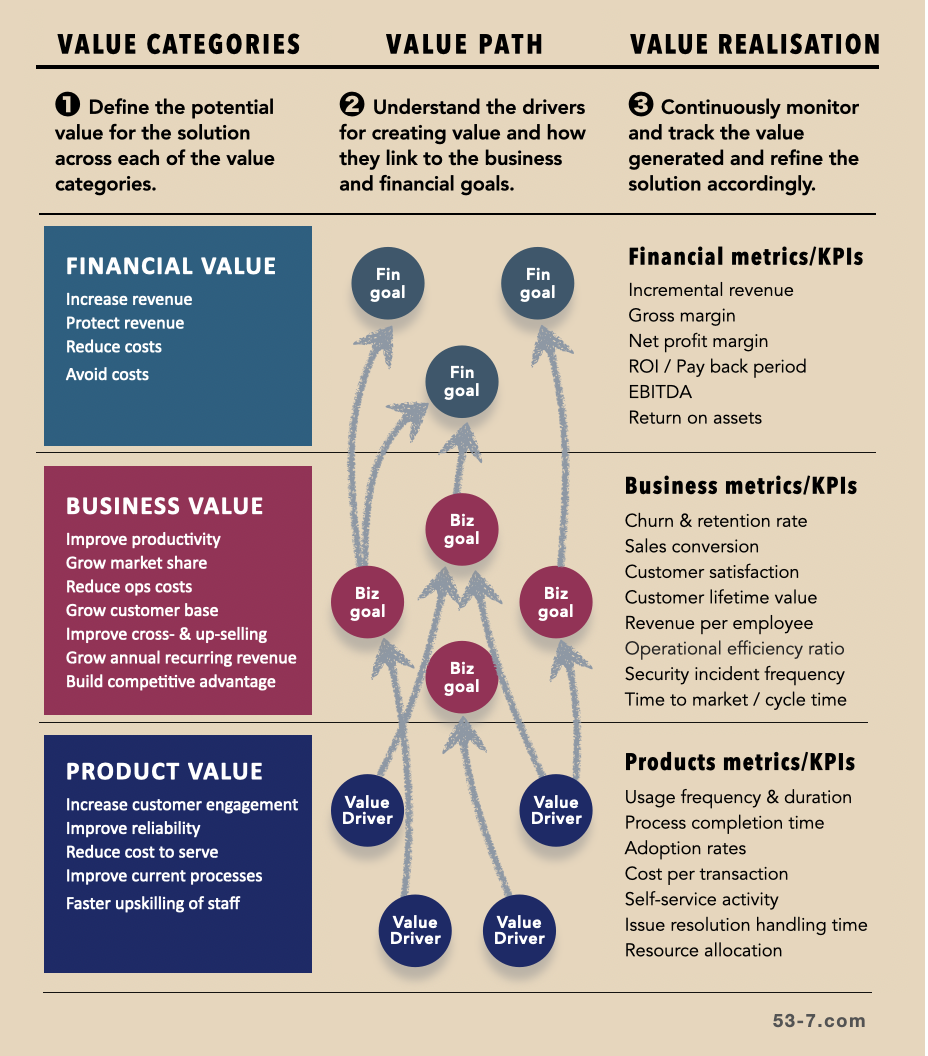A framework for delivering value
Ask ten people what ‘business value’ means and you’ll likely get ten different answers. Finance teams might think in terms of revenue, cost savings or ROI. Product teams may focus on customer engagement or adoption. Operational leaders might cite improved processes or faster delivery. These interpretations aren’t wrong, they’re just partial. Everyone sees value through their own lens.
But here’s the real question: how many of us can clearly explain how we deliver business value, and back it up with evidence?
In business value case discussions, whether you're seeking investment, buy-in or ongoing support, it’s not enough to describe what a solution does. You must be able to show where and how it delivers value, how that value links to strategic goals, and how you’ll measure whether it succeeds.
This is where a value delivery framework becomes essential.
Why you need a framework
Too many technology solutions, whether SaaS, Gen AI pilots, digital product innovations or core modernisation, are designed and delivered with minimal connection to strategic or financial value. We see outputs: dashboards, features, tools. But not outcomes: measurable changes to cost, revenue, customer satisfaction or productivity.
A structured framework helps avoid this pitfall by focusing attention on the value path: the chain of logic and evidence linking what you’re building to the results the business cares about.
The value delivery framework provides three steps:
Define the value goals
Understand how value is delivered
Monitor and track value generation
Let’s look at each step in more detail.
Step 1 – Define the value goals
Start by identifying what financial, business and product value looks like for your initiative.
This isn’t about writing a vague ambition like “deliver better insights” or “improve the customer experience”. It means articulating what outcomes matter to the business and how the solution supports them.
For example:
Financial value: Will it increase revenue, protect existing income, reduce costs or avoid future spend?
Business value: Will it improve productivity, reduce friction in operations, support growth, or build competitive advantage?
Product value: Will it increase adoption, reliability or engagement? Will it reduce service effort or speed up onboarding?
The key is to avoid a surface-level or localised view of value. Aligning goals from the top-down (strategy) and bottom-up (user and team needs) ensures a stronger case and a more focused delivery.
Ask:
What problem is the business trying to solve?
Who will use or benefit from the solution?
What is the value exchange between us and them?
Step 2 – Understand how value is delivered
Once value goals are defined, the next step is to understand how the solution actually delivers them.
This means identifying value drivers—the specific features, capabilities, or use cases that drive progress against those goals.
For instance, let’s say you’re implementing a SaaS platform. The ability to automate a manual process might reduce cycle time (a business value), which in turn reduces operational cost (a financial value). Or you might be piloting Gen AI to accelerate customer service responses, creating product value through faster issue resolution, leading to increased satisfaction and retention.
Mapping these drivers to business and financial goals helps estimate the potential impact (low, medium or high), and identifies the data you’ll need to build a business case.
That means:
KPIs and metrics for each value category
Current-state benchmarks and baselines
Research and data on market, customers and usage patterns
Ask:
What constraints or friction points are blocking value today?
Where are we burning resources or missing revenue opportunities?
Could this solution negatively impact any critical business goals?
This stage starts to generate the hard data needed to estimate ROI, payback periods or cost-to-serve improvements.
Step 3 – Monitor and track value generation
Value is a hypothesis until proven. Without ongoing tracking, you can’t know whether your solution is delivering what was promised, or how to adjust if it isn’t.
That’s why every value goal must be accompanied by a relevant metric.
These might include:
Financial: revenue, margin, ROI, payback period
Business: churn, conversion, satisfaction, operational efficiency
Product: usage, adoption, self-service, issue resolution
It’s important to maintain a clear line of sight between leading indicators (early usage or engagement) and lagging indicators (retention, revenue, savings). This allows course correction as you learn what works and what doesn’t.
Equally important: define who is responsible for value tracking, what infrastructure supports it, and what level of risk is acceptable.
Ask:
How will we measure success?
Who owns each metric?
What capabilities do we need to track and report it?
This step closes the loop ensuring you don’t just assume value has been delivered, but actually measure it and refine the solution to maximise impact.
In summary
Delivering business value is not a passive outcome. It requires intentional design, consistent alignment and disciplined measurement.
This framework helps ensure your solutions, whether incremental or innovative, are built on a foundation of measurable value. It provides a shared language across functions, connects technical delivery with commercial outcomes, and strengthens business cases for investment.
The reality? It’s not unusual to see solutions that are beautifully designed, technically sound, and yet fail to create meaningful impact, because they were never truly connected to business and financial value in the first place.
So how do you ensure your teams deliver value, not just outputs?
I’d love to hear your experiences, thoughts or challenges in driving real business impact through technology.

